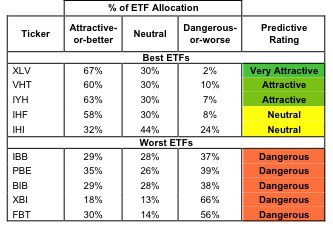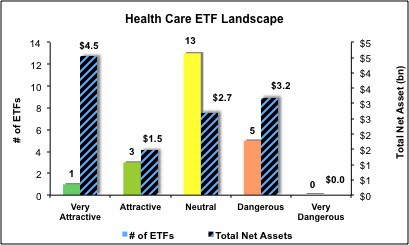The Health Care sector ranks third out of the ten sectors as detailed in my sector roadmap. It gets my Neutral rating, which is based on aggregation of the ratings of 22 ETFs and 83 mutual funds in the Health Care sector as of July 11, 2012. Reports on the best & worst ETFs and mutual funds in every sector and style are here.
Figures 1 and 2 show the five best and worst-rated ETFs and mutual funds in the sector. Not all Health Care sector ETFs and mutual funds are created the same. The number of holdings varies widely (from 20 to 296), which creates drastically different investment implications and ratings. The best ETFs and mutual funds allocate more value to Attractive-or-better-rated stocks than the worst ETFs and mutual funds, which allocate too much value to Neutral-or-worse-rated stocks.
To identify the best and avoid the worst ETFs and mutual funds within the Health Care sector, investors need a predictive rating based on (1) stocks ratings of the holdings and (2) the all-in expenses of each ETF and mutual fund. Investors need not rely on backward-looking ratings. My fund rating methodology is detailed here.
Investors seeking exposure to the Health Care sector should buy one of the Attractive-or-better rated ETFs or mutual funds from Figures 1 and 2.
See ratings and reports on all ETFs and mutual funds in this sector on my free mutual fund and ETF screener.
Figure 1: ETFs with the Best & Worst Ratings – Top 5

Sources: New Constructs, LLC and company filings
Focus Morningstar Health Care Index ETF (FHC) is excluded from Figure 1 because its total net assets (TNA) are below $100 million and do not meet our liquidity standards.
Figure 2: Mutual Funds with the Best & Worst Ratings – Top 5

Sources: New Constructs, LLC and company filings
8 mutual funds are excluded from Figure 2 because their total net assets (TNA) are below $100 million and do not meet our liquidity standards.
Health Care Select Sector SPDR (XLV) is my top-rated Health Care ETF and Vanguard World Funds: Vanguard Health Care Index Fund (VHCIX) is my top-rated Health Care mutual fund. XLV earns my Very Attractive rating and VHCIX earns my Attractive rating.
First Trust NYSE Arca Biotechnology Index Fund (FBT) is my worst-rated Health Care ETF and Fidelity Advisor Series VII: Fidelity Advisor Biotechnology Fund (FBTAX) is my worst-rated Health Care mutual fund. FBT earns my Dangerous rating and FBTAX earns my Very Dangerous rating.
Figure 3 shows that 83 out of the 344 stocks (over 56% of the total net assets) held by Health Care ETFs and mutual funds get an Attractive-or-better rating. However, only 4 out of 22 Health Care ETFs (over 50% of total net assets) and 8 out of 83 Health Care mutual funds (over 56% of total net assets) get an Attractive-or-better rating.
The takeaway is: the vast majority ETFs and mutual fund managers (81% of Health Care ETFs and 90% of Health Care mutual funds) allocate too much capital to low-quality stocks.
Investors, however, have successfully identified Attractive-or-better rated ETFs and mutual funds that hold great stocks and charge low fees. Figure 3 shows that 50% of the total net assets in Health Care ETFs and 56% of total net assets in Health Care mutual funds are allocated to the 4 ETFs and 8 mutual funds that earn an Attractive-or-better rating.
Figure 3: Health Care Sector Landscape For ETFs, Mutual Funds & Stocks
As detailed in “Cheap Funds Dupe Investors”, the fund industry offers many cheap funds but very few funds with high-quality stocks, or with what I call good portfolio management.
Investors need to tread carefully when considering Health Care ETFs and mutual funds, because 81% of the ETFs and 90% of the mutual funds are rated Neutral-or-worse, with 68% of mutual funds getting a Dangerous or Very Dangerous rating. Only 4 ETFs and 8 mutual funds in the Health Care sector (19% of ETFs and 10% of mutual funds) allocate enough capital to Attractive-or-better-rated stocks in order to earn an Attractive rating.
AmerisourceBergen Corporation (ABC) is one of my favorite stocks held by Health Care ETFs and mutual funds and earns my Very Attractive rating. AmerisourceBergen has shown consistent NOPAT growth over the last 5+ years with rising Economic Earnings and an ROIC of 15.5% in the most recent year. The company is highly profitable, but the current stock price implies that AmerisourceBergen’s profits will permanently decline by 21%. The mix of consistent economic profitability and a price that implies low expectations going forward offers an attractive risk/reward trade-off for investors.
MedAssets Inc. (MDAS) is one of my least favorite stocks held by Health Care ETFs and mutual funds and earns my Very Dangerous rating. For the past three years, MedAssets has earned an ROIC below its WACC, which means the returns the company generates on the capital that has been invested in the business are not sufficient to create value for shareholders. Not only has MedAssets been a poor steward of shareholder capital, its current stock price implies dramatic improvement. In order to justify today’s price, the company would need to grow revenues at over 18% compounded annually for the next 20 years. Those are expectations that few companies could ever meet. The stock price’s implied high expectations, coupled with the consistent failure to create value for shareholders, means that this is a Very Dangerous stock to own.
Figures 4 and 5 show the rating landscape of all Health Care ETFs and mutual funds.
Our sector roadmap report ranks all sectors and highlights those that offer the best investments.
Figure 4: Separating the Best ETFs From the Worst ETFs
Figure 5: Separating the Best Mutual Funds From the Worst Mutual Funds
Review my full list of ratings and rankings along with free reports on all 22 ETFs and 83 mutual funds in the Health Care sector.
Disclosure: I receive no compensation to write about any specific stock, sector or theme.


